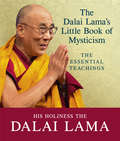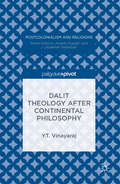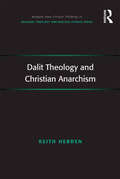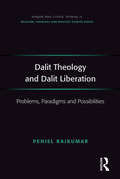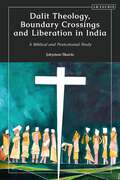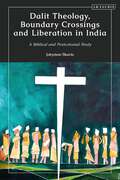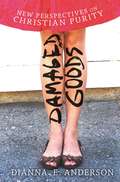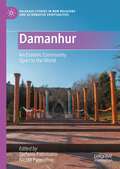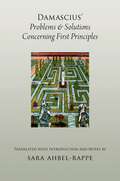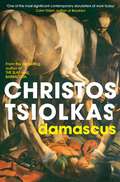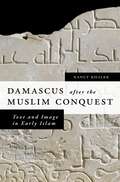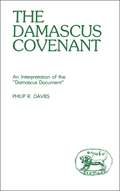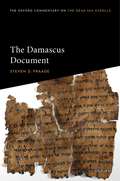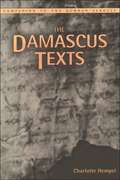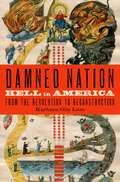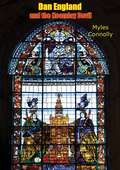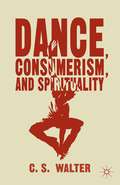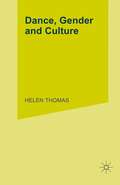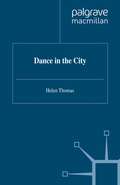- Table View
- List View
The Dalai Lama's Little Book of Mysticism: The Essential Teachings
by Dalai LamaMysticism is popularly understood as becoming one with God or the Absolute. Here in this inspirational book are the Dalai Lama’s thoughts on:The nature and meaning of mysticismHow we can live lives infused with mystical experienceHow mysticism can result in both personal and social change.The book consists of four sections that provide an accessible introduction to the Dalai Lama's core teachings on the mystical path:IntroductionQuotationsLecture on mysticism by the Dalai LamaGlossaryThis is a book for fans of His Holiness and anyone interested in developing a rich and meaningful inner life.
Dalit Theology after Continental Philosophy (Postcolonialism and Religions)
by Y.T. VinayarajThis book, steeped in the traditions of both postcolonial theory and Continental philosophy, addresses fundamental questions about God and theology in the postcolonial world. Namely, Y.T. Vinayaraj asks whether Continental philosophies of God and the ‘other’ can attend to the struggles that entail human pain and suffering in the postcolonial context. The volume offers a constructive proposal for a Dalit theology of immanent God or de-othering God as it emerges out of the Lokayata, the Indian materialist epistemology. Engaging with the post-Continental philosophers of immanence such as Gilles Deleuze, Giorgio Agamben, Catherine Malabou, and Jean-Luc Nancy, Vinayaraj explores the idea of a Dalit theology of God and body in the post-Continental context. The book investigates how there can be a Dalit theology of God without any Christian philosophical baggage of transcendentalism. The study ends with a clarion call for Indian Christian Theology to take a turn toward an immanence that is political and polydoxical in content.
Dalit Theology and Christian Anarchism (Routledge New Critical Thinking in Religion, Theology and Biblical Studies)
by Keith HebdenA second generation of emerging Dalit theology texts is re-shaping the way we think of Indian theology and liberation theology. This book is a vital part of that conversation. Taking post-colonial criticism to its logical end of criticism of statism, Keith Hebden looks at the way the emergence of India as a nation state shapes political and religious ideas. He takes a critical look at these Gods of the modern age and asks how Christians from marginalised communities might resist the temptation to be co-opted into the statist ideologies and competition for power. He does this by drawing on historical trends, Christian anarchist voices, and the religious experiences of indigenous Indians. Hebden's ability to bring together such different and challenging perspectives opens up radical new thinking in Dalit theology, inviting the Indian Church to resist the Hindu fundamentalists labelling of the Church as foreign by embracing and celebrating the anarchic foreignness of a Dalit Christian future.
Dalit Theology and Christian Anarchism (Routledge New Critical Thinking in Religion, Theology and Biblical Studies)
by Keith HebdenA second generation of emerging Dalit theology texts is re-shaping the way we think of Indian theology and liberation theology. This book is a vital part of that conversation. Taking post-colonial criticism to its logical end of criticism of statism, Keith Hebden looks at the way the emergence of India as a nation state shapes political and religious ideas. He takes a critical look at these Gods of the modern age and asks how Christians from marginalised communities might resist the temptation to be co-opted into the statist ideologies and competition for power. He does this by drawing on historical trends, Christian anarchist voices, and the religious experiences of indigenous Indians. Hebden's ability to bring together such different and challenging perspectives opens up radical new thinking in Dalit theology, inviting the Indian Church to resist the Hindu fundamentalists labelling of the Church as foreign by embracing and celebrating the anarchic foreignness of a Dalit Christian future.
Dalit Theology and Dalit Liberation: Problems, Paradigms and Possibilities (Routledge New Critical Thinking in Religion, Theology and Biblical Studies)
by Peniel RajkumarIn fulfilling the long-awaited need for a constructive and critical rethinking of Dalit theology this book offers and explores the synoptic healing stories as a relevant biblical paradigm for Dalit theology in order to help redress the lacuna between Dalit theology and the social practice of the Indian Church. Peniel Rajkumar's starting point is that the growing influence of Dalit theology in academic circles is incompatible with the praxis of the Indian Church which continues to be passive in its attitude towards the oppression of the Dalits both within and outside the Church. The theological reasons for this lacuna between Dalit theology and the Church's praxis, Rajkumar suggests, lie in the content of Dalit theology, especially the biblical paradigms explored, which do not offer adequate scope for engagement in praxis.
Dalit Theology and Dalit Liberation: Problems, Paradigms and Possibilities (Routledge New Critical Thinking in Religion, Theology and Biblical Studies)
by Peniel RajkumarIn fulfilling the long-awaited need for a constructive and critical rethinking of Dalit theology this book offers and explores the synoptic healing stories as a relevant biblical paradigm for Dalit theology in order to help redress the lacuna between Dalit theology and the social practice of the Indian Church. Peniel Rajkumar's starting point is that the growing influence of Dalit theology in academic circles is incompatible with the praxis of the Indian Church which continues to be passive in its attitude towards the oppression of the Dalits both within and outside the Church. The theological reasons for this lacuna between Dalit theology and the Church's praxis, Rajkumar suggests, lie in the content of Dalit theology, especially the biblical paradigms explored, which do not offer adequate scope for engagement in praxis.
Dalit Theology, Boundary Crossings and Liberation in India: A Biblical and Postcolonial Study
by Jobymon SkariaJobymon Skaria, an Indian St Thomas Christian Scholar, offers a critique of Indian Christian theology and suggests that constructive dialogues between Biblical and dissenting Dalit voices – such as Chokhamela, Karmamela, Ravidas, Kabir, Nandanar and Narayana Guru – could set right the imbalance within Dalit theology, and could establish dialogical partnerships between Dalit Theologians, non-Dalit Christians and Syrian Christians. Drawing on Biblical and socio-historical resources, this book examines a radical, yet overlooked aspect of Dalit cultural and religious history which would empower the Dalits in their everyday existences.
Dalit Theology, Boundary Crossings and Liberation in India: A Biblical and Postcolonial Study
by Jobymon SkariaJobymon Skaria, an Indian St Thomas Christian Scholar, offers a critique of Indian Christian theology and suggests that constructive dialogues between Biblical and dissenting Dalit voices – such as Chokhamela, Karmamela, Ravidas, Kabir, Nandanar and Narayana Guru – could set right the imbalance within Dalit theology, and could establish dialogical partnerships between Dalit Theologians, non-Dalit Christians and Syrian Christians. Drawing on Biblical and socio-historical resources, this book examines a radical, yet overlooked aspect of Dalit cultural and religious history which would empower the Dalits in their everyday existences.
Damaged Goods: New Perspectives on Christian Purity
by Dianna AndersonDianna Anderson offers a fresh approach to the purity conversation, one that opens a new dialogue with the most influential Christian authors of her generation. Anderson's new sexual ethics draw on core biblical principles and set a standard for today's Christians that may be as influential Joshua Harris' I Kissed Dating Goodbye, Don Raunikar's Choosing God's Best, and Elisabeth Elliot's Passion and Purity. Anderson uses her own illuminating experience with the purity movement to: Reach out to women and men trying to reconcile their own sexuality with their understanding of "what God wants," cultural stigma, and media pressuresDemonstrate how Christian ideas about purity have infiltrated American politics and culture-and why women are losingOffer an affirmative, healing path for everyone to understand their sexuality: one that reconciles scripture, culture, and common sense Provocative and engaging, she will revolutionize the way you think about sex, abstinence, politics, and faith.
Damaged Goods: New Perspectives on Christian Purity
by Dianna AndersonDianna Anderson offers a fresh approach to the purity conversation, one that opens a new dialogue with the most influential Christian authors of her generation.Anderson's new sexual ethics draw on core biblical principles and set a standard for today's Christians that may be as influential Joshua Harris' I Kissed Dating Goodbye, Don Raunikar's Choosing God's Best, and Elisabeth Elliot's Passion and Purity. Anderson uses her own illuminating experience with the purity movement to: Reach out to women and men trying to reconcile their own sexuality with their understanding of "what God wants," cultural stigma, and media pressuresDemonstrate how Christian ideas about purity have infiltrated American politics and culture-and why women are losingOffer an affirmative, healing path for everyone to understand their sexuality: one that reconciles scripture, culture, and common sense.Provocative and engaging, she will revolutionize the way you think about sex, abstinence, politics, and faith.
Damanhur: An Esoteric Community Open to the World (Palgrave Studies in New Religions and Alternative Spiritualities)
by Stefania Palmisano Nicola PannofinoThe Damanhur Federation, situated in Valchiusella, North-West Italy, is one of Europe’s longest-lasting spiritual-esoteric communities. Nevertheless, there has hitherto been nearly no scientific study of this group, with the exception of a handful of specialised-journal articles. This collection fills that gap by collating the various scholarly contributions which over the years have dealt with Damanhur, aiming to present the phenomenon to a public of specialists, students and people who are just curious in a volume focusing on the multidisciplinary nature of the community as a whole. We consider the various spheres making up the social, cultural, spiritual and organisational life of Damanhur through analysis and interpretation of its historical evolution and more recent changes which have affected the community since its founder’s death. The contributions combine field research with theoretical reflection, making use of both qualitative (discursive interviews and participant observation) and quantitative (questionnaires) methods.
Damascius' Problems and Solutions Concerning First Principles (AAR Religions in Translation)
by Sara Ahbel-RappeDamascius was head of the Neoplatonist academy in Athens when the Emperor Justinian shut its doors forever in 529. His work, Problems and Solutions Concerning First Principles, is the last surviving independent philosophical treatise from the Late Academy. Its survey of Neoplatonist metaphysics, discussion of transcendence, and compendium of late antique theologies, make it unique among all extant works of late antique philosophy. It has never before been translated into English. The Problems and Solutions exhibits a thorough?going critique of Proclean metaphysics, starting with the principle that all that exists proceeds from a single cause, proceeding to critique the Proclean triadic view of procession and reversion, and severely undermining the status of intellectual reversion in establishing being as the intelligible object. Damascius investigates the internal contradictions lurking within the theory of descent as a whole, showing that similarity of cause and effect is vitiated in the case of processions where one order (e.g. intellect) gives rise to an entirely different order (e.g. soul). Neoplatonism as a speculative metaphysics posits the One as the exotic or extopic explanans for plurality, conceived as immediate, present to hand, and therefore requiring explanation. Damascius shifts the perspective of his metaphysics: he struggles to create a metaphysical discourse that accommodates, insofar as language is sufficient, the ultimate principle of reality. After all, how coherent is a metaphysical system that bases itself on the Ineffable as a first principle? Instead of creating an objective ontology, Damascius writes ever mindful of the limitations of dialectic, and of the pitfalls and snares inherent in the very structure of metaphysical discourse.
Damascius' Problems and Solutions Concerning First Principles (AAR Religions in Translation)
by Sara Ahbel-RappeDamascius was head of the Neoplatonist academy in Athens when the Emperor Justinian shut its doors forever in 529. His work, Problems and Solutions Concerning First Principles, is the last surviving independent philosophical treatise from the Late Academy. Its survey of Neoplatonist metaphysics, discussion of transcendence, and compendium of late antique theologies, make it unique among all extant works of late antique philosophy. It has never before been translated into English. The Problems and Solutions exhibits a thorough?going critique of Proclean metaphysics, starting with the principle that all that exists proceeds from a single cause, proceeding to critique the Proclean triadic view of procession and reversion, and severely undermining the status of intellectual reversion in establishing being as the intelligible object. Damascius investigates the internal contradictions lurking within the theory of descent as a whole, showing that similarity of cause and effect is vitiated in the case of processions where one order (e.g. intellect) gives rise to an entirely different order (e.g. soul). Neoplatonism as a speculative metaphysics posits the One as the exotic or extopic explanans for plurality, conceived as immediate, present to hand, and therefore requiring explanation. Damascius shifts the perspective of his metaphysics: he struggles to create a metaphysical discourse that accommodates, insofar as language is sufficient, the ultimate principle of reality. After all, how coherent is a metaphysical system that bases itself on the Ineffable as a first principle? Instead of creating an objective ontology, Damascius writes ever mindful of the limitations of dialectic, and of the pitfalls and snares inherent in the very structure of metaphysical discourse.
Damascus
by Christos Tsiolkas'We are despised, yet we grow. We are tortured and crucified and yet we flourish. We are hated and still we multiply. Why is that? You must wonder, how is it we survive?' In a far corner of the Roman Empire, a radical sect is growing. Alone, unloved and battling his sexuality, Saul scrapes together a living exposing these nascent Christians, but on the road to Damascus, everything changes.Saul - now Paul - becomes drawn into this new religion and its mysterious leader, whose crucifixion leaves followers waiting in limbo for his promised return. As factions splinter and competition to create the definitive version of Christ's life grows violent, he begins to question his new faith and the man at its heart.Damascus is an unflinching dissection of doubt, faith, tyranny, revolution, cruelty and sacrifice. A vivid and visceral novel with perennial concerns, it is a masterpiece of imagination and transformation.
Damascus after the Muslim Conquest: Text and Image in Early Islam
by Nancy KhalekBefore it fell to Muslim armies in AD 635-6 Damascus had a long and prestigious history as a center of Christianity. How did this city, which became the capitol of the Islamic Empire and its people, negotiate the transition from a late antique or early Byzantine world to an Islamic culture? In Damascus after the Muslim Conquest, Nancy Khalek demonstrates that the changes that took place in Syria during this formative period of Islamic life were not simply a matter of the replacement of one civilization by another as a result of military conquest, but rather of shifting relationships and practices in a multifaceted social and cultural setting. Even as late antique forms of religion and culture persisted, the formation of Islamic identity was affected by the people who constructed, lived in, and narrated the history of their city. Khalek draws on the evidence of architecture and the testimony of pilgrims, biographers, geographers, and historians to shed light on this process of identity formation. Offering a fresh approach to the early Islamic period, she moves the study of Islamic origins beyond a focus on issues of authenticity and textual criticism, and initiates an interdisciplinary discourse on narrative, storytelling, and the interpretations of material culture.
The Damascus Covenant: An Interpretation of the 'Damascus Document' (The Library of Hebrew Bible/Old Testament Studies)
by Philip R. DaviesThe Damascus Document is the most important witness to the origins of the Qumran community. The author surveys previous research, with particular emphasis on the syntheses of H. Stegemann and J. Murphy-O'Connor. A more comprehensive view of the redaction and ideology of the document is offered, leading to the conclusion that it is originally a product of a community which traced its origins to the Babylonian exile. The extant Cairo manuscripts represent a Qumran recension, confirming the opinion of many scholars that the Qumran community originated as a splinter movement from an earlier and larger community. The Hebrew text and a translation are provided.
The Damascus Document (Oxford Commentary on the Dead Sea Scrolls)
by Steven D. FraadeSteve D. Fraade offers a new translation, with notes, and detailed commentary to the Dead Sea Scroll most commonly called the Damascus Document, based on both ancient manuscripts from caves along the western shore of the Dead Sea, and medieval manuscripts from the Cairo Geniza. The text is one of the longest and most important of the Dead Sea Scrolls. Its importance derives from several aspects of its contents: its extensive collections of laws, both for the sectarian community that authored it and for the rest of Israel; some of the oldest examples of scriptural interpretation, both legal and narrative, both implicit and explicit, with important implications for our understanding of the evolving status of the Hebrew canon; some of the clearest expressions, often in hortatory form, of the community's self-understanding as an elect remnant of Israel that understands itself in dualistic opposition to the rest of Israel, its practices, and its leaders; important expressions of the community's self-understanding as a priestly alternative to the sacrificial worship in the Jerusalem Temple; expressions of an apocalyptic, eschatological understanding of living as the true Israel in the "end of days;" important expressions of attitudes toward woman, sexual activity, and marriage; importance for our understanding of ancient modes of teaching and of ritual practice; importance for the study of the history of the Hebrew language and its scribal practices. The volume contains a substantial introduction, dealing with these aspects of the Damascus Document and locating its place within the Dead Sea Scrolls more broadly as well as the historical context of ancient Judaism that gave rise to this text.
The Damascus Document (Oxford Commentary on the Dead Sea Scrolls)
by Steven D. FraadeSteve D. Fraade offers a new translation, with notes, and detailed commentary to the Dead Sea Scroll most commonly called the Damascus Document, based on both ancient manuscripts from caves along the western shore of the Dead Sea, and medieval manuscripts from the Cairo Geniza. The text is one of the longest and most important of the Dead Sea Scrolls. Its importance derives from several aspects of its contents: its extensive collections of laws, both for the sectarian community that authored it and for the rest of Israel; some of the oldest examples of scriptural interpretation, both legal and narrative, both implicit and explicit, with important implications for our understanding of the evolving status of the Hebrew canon; some of the clearest expressions, often in hortatory form, of the community's self-understanding as an elect remnant of Israel that understands itself in dualistic opposition to the rest of Israel, its practices, and its leaders; important expressions of the community's self-understanding as a priestly alternative to the sacrificial worship in the Jerusalem Temple; expressions of an apocalyptic, eschatological understanding of living as the true Israel in the "end of days;" important expressions of attitudes toward woman, sexual activity, and marriage; importance for our understanding of ancient modes of teaching and of ritual practice; importance for the study of the history of the Hebrew language and its scribal practices. The volume contains a substantial introduction, dealing with these aspects of the Damascus Document and locating its place within the Dead Sea Scrolls more broadly as well as the historical context of ancient Judaism that gave rise to this text.
Damascus Texts (Companion to the Qumran Scrolls)
by Charlotte HempelThe Damascus document is one of the most important texts from the Qumran caves. Part One of this Companion offers a lucid and up-to-date introduction to all the manuscripts, including the eight recently published from Qumran Cave 4. It also provides a review of the key areas of scholarly research on this important Qumran text. Part Two is devoted to the recently published text 4QMiscellaneous Rules (4Q265; olim Serekh Damascus). This text has already become the subject of intense interest among students of the Dead Sea Scrolls because of its unique relationship to both the Community Rule and the Damascus Document.
Damned Nation: Hell in America from the Revolution to Reconstruction
by Kathryn Gin LumAmong the pressing concerns of Americans in the first century of nationhood were day-to-day survival, political harmony, exploration of the continent, foreign policy, and--fixed deeply in the collective consciousness--hell and eternal damnation. The fear of fire and brimstone and the worm that never dies exerted a profound and lasting influence on Americans' ideas about themselves, their neighbors, and the rest of the world. Kathryn Gin Lum poses a number of vital questions: Why did the fear of hell survive Enlightenment critiques in America, after largely subsiding in Europe and elsewhere? What were the consequences for early and antebellum Americans of living with the fear of seeing themselves and many people they knew eternally damned? How did they live under the weighty obligation to save as many souls as possible? What about those who rejected this sense of obligation and fear? Gin Lum shows that beneath early Americans' vaunted millennial optimism lurked a pervasive anxiety: that rather than being favored by God, they and their nation might be the object of divine wrath. As time-honored social hierarchies crumbled before revival fire, economic unease, and political chaos, "saved" and "damned" became as crucial distinctions as race, class, and gender. The threat of damnation became an impetus for or deterrent from all kinds of behaviors, from reading novels to owning slaves. Gin Lum tracks the idea of hell from the Revolution to Reconstruction. She considers the ideas of theological leaders like Jonathan Edwards and Charles Finney, as well as those of ordinary women and men. She discusses the views of Native Americans, Americans of European and African descent, residents of Northern insane asylums and Southern plantations, New England's clergy and missionaries overseas, and even proponents of Swedenborgianism and annihilationism. Damned Nation offers a captivating account of an idea that played a transformative role in America's intellectual and cultural history.
Damned Nation: Hell in America from the Revolution to Reconstruction
by Kathryn Gin LumAmong the pressing concerns of Americans in the first century of nationhood were day-to-day survival, political harmony, exploration of the continent, foreign policy, and--fixed deeply in the collective consciousness--hell and eternal damnation. The fear of fire and brimstone and the worm that never dies exerted a profound and lasting influence on Americans' ideas about themselves, their neighbors, and the rest of the world. Kathryn Gin Lum poses a number of vital questions: Why did the fear of hell survive Enlightenment critiques in America, after largely subsiding in Europe and elsewhere? What were the consequences for early and antebellum Americans of living with the fear of seeing themselves and many people they knew eternally damned? How did they live under the weighty obligation to save as many souls as possible? What about those who rejected this sense of obligation and fear? Gin Lum shows that beneath early Americans' vaunted millennial optimism lurked a pervasive anxiety: that rather than being favored by God, they and their nation might be the object of divine wrath. As time-honored social hierarchies crumbled before revival fire, economic unease, and political chaos, "saved" and "damned" became as crucial distinctions as race, class, and gender. The threat of damnation became an impetus for or deterrent from all kinds of behaviors, from reading novels to owning slaves. Gin Lum tracks the idea of hell from the Revolution to Reconstruction. She considers the ideas of theological leaders like Jonathan Edwards and Charles Finney, as well as those of ordinary women and men. She discusses the views of Native Americans, Americans of European and African descent, residents of Northern insane asylums and Southern plantations, New England's clergy and missionaries overseas, and even proponents of Swedenborgianism and annihilationism. Damned Nation offers a captivating account of an idea that played a transformative role in America's intellectual and cultural history.
Dan England and the Noonday Devil
by Myles ConnollyA joyous gent who sings of the glory of the true realities of life, Dan England chose “talking” as his vocation in life. This he did, joyously and beautifully. He talked to the poets without dreams, actors who couldn’t act, and writers who couldn’t write who came to his house for an evening to listen and stayed on for months…years.Not a few found new hope as they heard him capture the poetry of living in his talk of saints, and in stories about his greatness of God’s gifts (among which was the wine that gave added sparkle to his words). There was Briggs, the religion editor without religion to become a fearless “defender of the faith” under Dan’s influence. And Tim, the janitor who “exposed” the corruption of the Match Industry when in an idle hour’s count of a box of matches he found “four” missing. For the glorious length of a Dan England discourse the retiring little janitor became a tiger for reform.This is the latest troubadour of life-beautiful to come from the pen of the author of the classic Mr. Blue.
Dance, Consumerism, and Spirituality
by C. WalterDance has proliferated in movies, television, Internet, and retail spaces while the spiritual power of dance has also been linked with mass consumption. Walter marries the cultural studies of dance and the religious aspects of dance in an exploration of consumption rituals, including rituals of being persuaded to buy products that include dance.
Dance, Gender and Culture
by Helen Thomas'...full credit to Thomas and Macmillan for embarking on such a worthwhile venture - Dance Research I have already found the Thomas edition of enormous value in teaching both undergraduates and postgraduates, from the perspectives of dance anthropology, ethnography and theatre dance analysis - Theresa Buckland, Department of Dance Studies, University of Surrey This unique collection of papers, written specially for this volume, explores the aspects of the ways in which dance and gender intersect in a variety of cultural contexts, from social and disco dance to performance dance, to the Hollywood musical and dances from different cultures. The contributors come from a broad range of disciplines, such as cultural studies, anthropology, sociology, dance studies, film studies, and journalism. They bring to the book a wide body of ideas and approaches, including feminism, psychoanalysis, ethnography and subcultural theory. List of Plates - Preface to the 1995 Reprint - Notes on the Contributors - Introduction - PART 1: CULTURAL STUDIES - Dance, Gender and Culture; T.Polhumus - Dancing in the Dark: Rationalism and the Neglect of Social Dance; A.Ward - Ballet, Gender and Cultural Power; C.J.Novack - 'I Seem to Find the Happiness I Seek': Heterosexuality and Dance in the Musical; R.Dyer - PART 2: ETHNOGRAPHY - An-Other Voice: Young Women Dancing and Talking; H.Thomas - Gender Interchangeability among the Tiwi; A.Grau - 'Saturday Night Fever': An Ethnography of Disco Dancing; D.Walsh - Classical Indian Dance and Women's Status; J.L.Hanna - PART 3: THEORY/CRITICISM - Dance, Feminism and the Critique of the Visual; R.Copeland - 'You put your left foot in, then you shake it all about ...': Excursions and Incursions into Feminism and Bausch's Tanztheater; A.Sanchez-Colberg - 'She might pirouette on a daisy and it would not bend': Images of Femininity and Dance Appreciation; L-A.Sayers - Still Dancing Downwards and Talking Back; Z.Oyortey - The Anxiety of Dance Performance; V.Rimmer - Index
Dance in the City
by Helen ThomasThis exciting new and original collection locates dance within the spectrum of urban life in late modernity, through a range of theoretical perspectives. It highlights a diversity of dance forms and styles that can be witnessed in and around contemporary urban spaces: from dance halls to raves and the club striptease; from set dancing to ballroom dancing, to hip hop and swing, and to ice dance shows; from the ballet class, to fitness aerobics; and 'art' dance which situates itself in a dynamic relation to the city.
